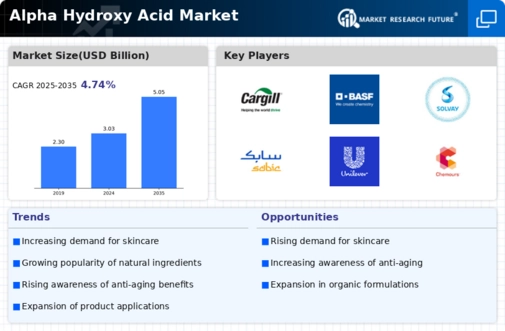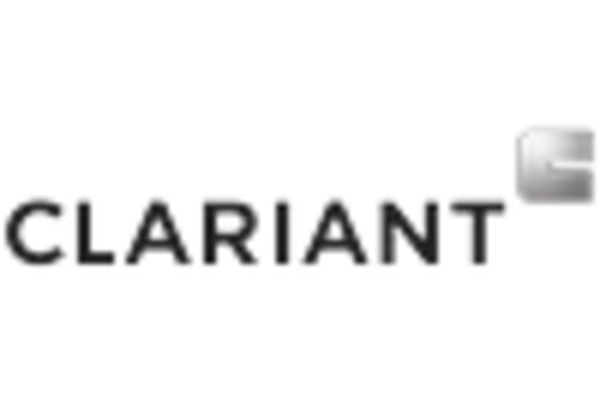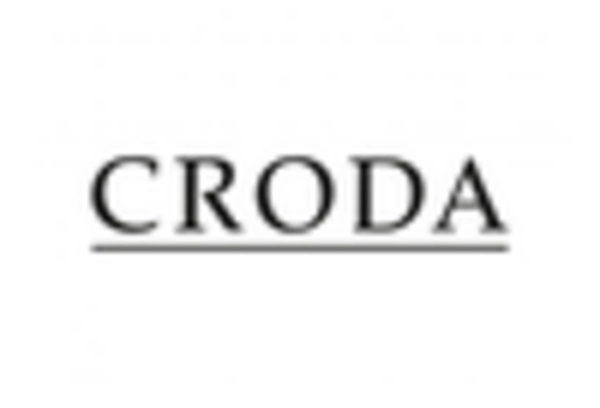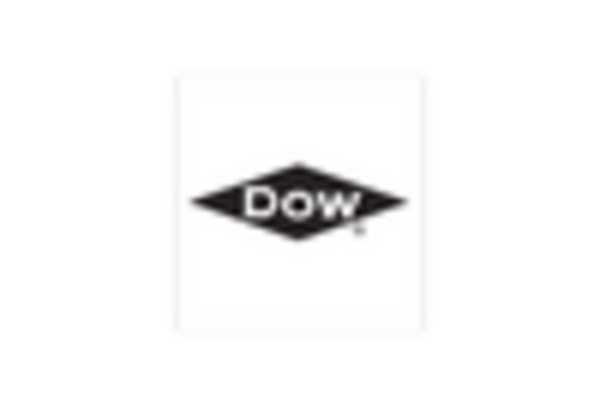Market Growth Projections
The Global Alpha Hydroxy Acid Market Industry is projected to experience substantial growth, with estimates indicating a market value of 3.03 USD Billion in 2024 and a potential rise to 5.05 USD Billion by 2035. This growth trajectory suggests a compound annual growth rate of 4.75% from 2025 to 2035, reflecting the increasing consumer demand for effective skincare solutions. The market's expansion is likely to be fueled by innovations in product formulations, the rising popularity of AHAs in various cosmetic applications, and the growing awareness of skincare benefits among consumers. These projections highlight the dynamic nature of the industry and its responsiveness to evolving consumer preferences.
Expansion of Cosmetic Applications
The Global Alpha Hydroxy Acid Market Industry benefits from the expanding applications of AHAs in cosmetic formulations. These acids are increasingly incorporated into a variety of products, including cleansers, toners, and moisturizers, due to their effectiveness in promoting skin renewal and hydration. The versatility of AHAs allows manufacturers to innovate and create multifunctional products that cater to diverse consumer needs. As the industry evolves, the integration of AHAs into anti-aging and acne treatment products is likely to enhance their appeal. This diversification of applications contributes to the anticipated growth of the market, projected to reach 5.05 USD Billion by 2035.
Rising Demand for Skincare Products
The Global Alpha Hydroxy Acid Market Industry experiences a notable surge in demand for skincare products, driven by increasing consumer awareness regarding skin health and aesthetics. With a projected market value of 3.03 USD Billion in 2024, the industry reflects a growing inclination towards chemical exfoliants that enhance skin texture and appearance. This trend is particularly evident among millennials and Gen Z consumers, who prioritize skincare routines. The proliferation of social media platforms further amplifies the visibility of skincare products, leading to heightened consumer interest and engagement. As a result, the Global Alpha Hydroxy Acid Market Industry is poised for sustained growth.
Emerging Markets and Demographic Shifts
The Global Alpha Hydroxy Acid Market Industry is experiencing growth in emerging markets, where rising disposable incomes and changing demographics contribute to increased spending on personal care products. As urbanization accelerates in regions such as Asia-Pacific and Latin America, consumers are becoming more exposed to global beauty trends. This exposure fosters a growing demand for effective skincare solutions, including AHAs. Additionally, the increasing prevalence of skin concerns, such as hyperpigmentation and aging, drives consumers to seek products that offer visible results. This demographic shift presents a significant opportunity for brands to expand their presence in these burgeoning markets.
Growing Interest in Natural Ingredients
The Global Alpha Hydroxy Acid Market Industry is witnessing a shift towards natural and organic ingredients, as consumers increasingly seek products that align with their health and environmental values. This trend is particularly relevant in the context of AHAs derived from fruit sources, such as glycolic acid from sugarcane and citric acid from citrus fruits. Brands that emphasize natural formulations are likely to attract a loyal customer base, as consumers become more discerning about ingredient transparency. This growing interest in natural ingredients may drive innovation in product development, potentially leading to new formulations that enhance the efficacy of AHAs while maintaining a focus on sustainability.
Increased Research and Development Activities
The Global Alpha Hydroxy Acid Market Industry is bolstered by heightened research and development activities aimed at exploring the full potential of AHAs in skincare. Ongoing studies investigate the efficacy of various AHA concentrations and their synergistic effects with other ingredients. This research not only enhances product formulations but also provides valuable insights into consumer preferences and skin health. As brands invest in R&D, they are likely to introduce advanced formulations that cater to specific skin concerns, thereby expanding their market reach. The anticipated compound annual growth rate of 4.75% from 2025 to 2035 underscores the importance of innovation in driving market growth.

















Leave a Comment